Question
Honeybees (Apis mellifera) are key pollinators in most ecosystems. The worldwide use of neonicotinoid pesticides has caused concern because they may be contributing to the decline of honeybee populations.
Scientists measured the concentration of five neonicotinoids (acetamiprid, clothianidin, imidacloprid, thiacloprid and thiamethoxam) in honey samples from 198 different locations across the world. Each pie chart shows the relative frequency of neonicotinoids in honey samples from a continent.
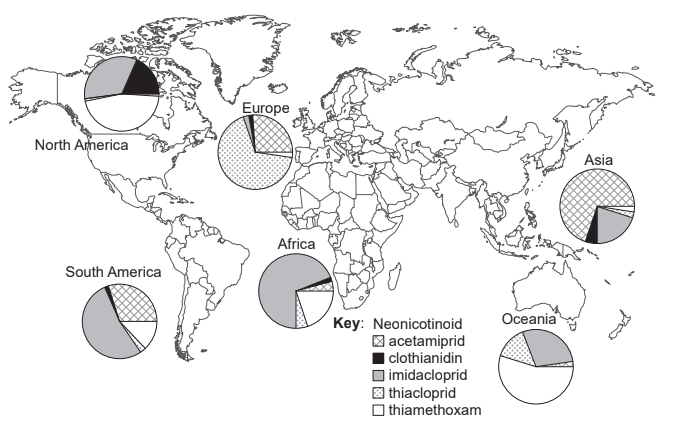
(a) Identify in which continent the fewest types of neonicotinoid were detected in honey samples.[1]
(b) Using the data, outline the different use of thiamethoxam in North and South America. [1]
The neonicotinoids can be used alone or together with other neonicotinoids. The percentage of honey samples with 0, 1, 2, 3, 4 or 5 different neonicotinoids in each continent are shown in the stacked bar chart.
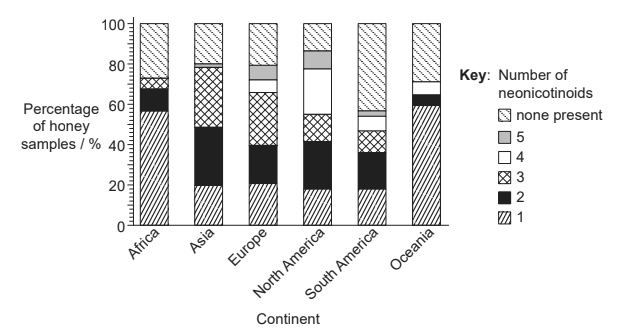
(c) Identify the total percentage of honey samples contaminated with neonicotinoid pesticides in the continent with the lowest overall levels of contamination.[1]
In order to grow, honeybee larvae are fed royal jelly, a high energy food with very high acetylcholine concentrations.
In an experiment, larvae were bred artificially on a diet with reduced acetylcholine content in the royal jelly. The graph shows the mean survival rate of these larvae compared to control larvae fed on a normal diet.
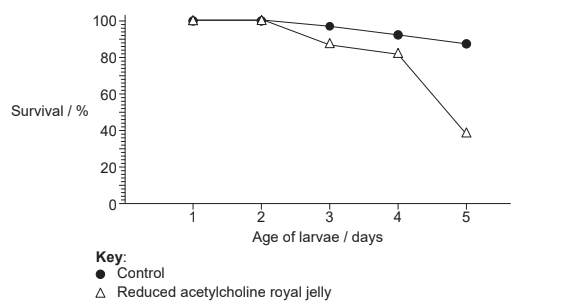
(d) Deduce the conclusions that can be drawn from the data in the graph. [2]
(e) Suggest a reason for the effect of a diet reduced in acetylcholine on the larval survival rate. [1]
The concentration of acetylcholine was measured in royal jelly produced by honeybees that had never been exposed to neonicotinoids (control) and honeybees that had been exposed for three weeks to two neonicotinoids; clothianidin and thiacloprid.
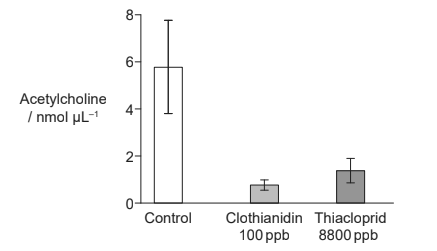
(f) Compare and contrast the effect of clothianidin and thiacloprid treatments on the concentration of acetylcholine in royal jelly. [2]
(g) Explain how neonicotinoids affect synaptic transmission in insects. [3]
(h) Companies that manufacture neonicotinoid pesticides have argued that they do not cause significant harm to honeybees. Construct an argument, based on the data in this question, for serious concern about the manufacture and use of neonicotinoid pesticides. [4]
▶️Answer/Explanation
Ans:
1. a Oceania
1. b thiamethoxam is the most used in North America (but not in South America) / CONVERSE OR
in South America they use different neonicotinoids to thiamethoxam OWTTE Allow numerical comparison.
1. c 57 (%) Allow range 56% to 58%.
1. d
a. reduced acetylcholine does not affect larval survival in the first two days
b. reduced acetylcholine causes increased mortality from day 3 onwards
c. 90% versus 40% survival/other valid numerical comparison by day 5 OR (much) greater decrease in survival occurs between days 4 and 5/by day 5 for the reduced group Do not accept answers without times/ days
1. e (larvae lacking acetylcholine/with reduced AcH cannot survive because) acetylcholine is a neurotransmitter taking message from one neuron to another in synapses of nervous tissues OR messages would not pass from one neuron to the other OR (larvae) unable to synthesise/produce AcH, so need it from their diet OWTTE1
1. f
a. both neonicotinoids reduce the concentration of acetylcholine in royal jelly (compared to control)
b. clothianidin reduces the concentration of acetylcholine in royal jelly more than thiacloprid (but perhaps not statistically different)
c. clothianidin is used in smaller concentrations (than thiacloprid) so no firm conclusion can be obtained Need one similarity and one difference.
1. g
a. neonicotinoids bind to the (acetylcholine) receptor (in insects)
b. (binding happens) in (cholinergic) synapses/at motor end plate/between motor neuron and muscles
c. neonicotinoids bind irreversibly (to receptors) OR (receptors are blocked so) acetylcholine is unable to bind
d. acetylcholinesterase/enzymes cannot break down neonicotinoids
e. (synaptic) transmission prevented
f. (causing) insect paralysis/death
1. h
a. neonicotinoids are used in every continent
b. the choice of specific neonicotinoid varies considerably around the world
c. neonicotinoids contaminate honey (so must get into honeybees)
d. only a minority of honey samples from around the world contain no neonicotinoids
e. neonicotinoids reduce the acetylcholine (content of royal jelly) OR only a small amount of clothianidin can reduce acetylcholine in royal jelly
f. survival of honeybee larvae is lower if the acetylcholine is lower/content of royal jelly is reduced
a. Outline the use of human embryonic stem cells (hESC) to treat Stargardt’s disease.[2]
▶️Answer/Explanation
Markscheme
a.
b. «an inherited form of» degeneration of retinal layer/photoreceptor cells/blindness
OR
eye genetic disorder
OWTTE
«hESC/stem cells» can provide/differentiate into healthy retinal cells
injecting «hESC/stem cells» into the retina/eye can restore vision in animal/human trials
b. correct allele identification
«eg: S=dominant/normal; s=recessive/disease»
correct Punnett grid
correct phenotypic ratio/outcome
example:
s =recessive, disease-causing form of gene,
S =dominant,
normal form parents =Ss.
Any letter can be used as capital and lower case but a legend/key is not required if correct notation is used.
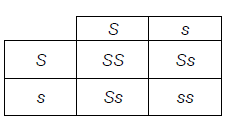
Do not award mp b if the gametes do not show heterozygous organisms
phenotypic ratio:
normal : with disease
OR
3 normal : 1 with disease
OR
«75 % normal :» 25 % disease
Question
Pictured below are Louis Pasteur’s original drawings of swan-necked flasks.
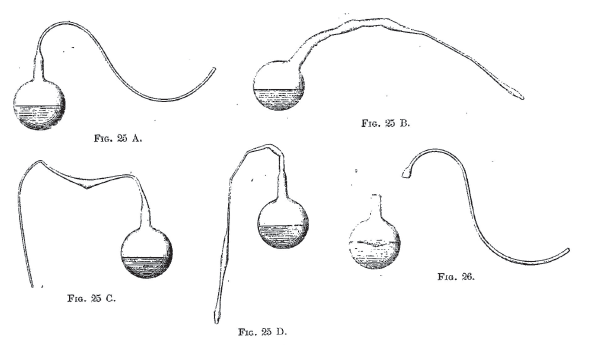
Describe how Pasteur’s experiments provided convincing evidence to falsify the concept of spontaneous generation.
State the function of life in Paramecium that is carried out by:
cilia.
State the function of life in Paramecium that is carried out by:
the contractile vacuole.
Discuss the advantages and disadvantages of the use of adult stem cells.
Explain the role of decomposers in an ecosystem.
▶️Answer/Explanation
Markscheme
a. spontaneous generation is life appearing from nothing / from non-living / cells only come from pre-existing cells/life
b. broth/culture medium (for bacteria) (used/placed) in flasks
c. broth boiled/sterilized «in some flasks» to kill microbes
d. no clouding/signs of bacterial growth/reproduction / microbes did not appear «in flasks of boiled broth»
Allow bacteria or organisms instead of microbes.
e. after necks of flasks were snapped boiled broth became cloudy/growth of microbes
f. because microbes from the air contaminated the «boiled» broth
g. curved necks allowed indirect exposure to air but prevented entry of microbes
movement/locomotion
OR
feeding/nutrition
homeostasis
OR
maintain osmotic balance / expels «excess» water / maintains «cell» water content
Advantages:
a. «adult stem cells» can divide «endlessly» / can differentiate
b. «adult stem cells» can be used to repair/regenerate «tissues»
c. fewer ethical objections «than with embryonic stem cells»
d. adults can give «informed» consent for use of their stem cells
e. adult source is not killed / «source» would not have grown into new human / no death of embryos used to provide stem cells
f. no rejection problems / patient’s own cells used
g. less chance of cancer/«malignant» tumor development «than from embryonic stem cells»
h. most tissues in adults contain some stem cells
Disadvantages:
i. difficult to obtain/collect/find in adult body/very few available
j. some «adult» tissues contain few/no stem cells
k. «adult stem cells» differentiate into fewer cell types «than embryonic cells» /OWTTE
a. saprotrophs/decomposers feed on/break down dead «organic» matter
b. saprotrophs/decomposers release energy «heat» accelerating decomposition/warming soil
c. saprotrophs/decomposers recycle nutrients / make nutrients available (to producers)
OR
improves soil fertility / returns nutrients (minerals/nitrates/phosphates/carbon)to soil/water/environment
d. saprotrophs/decomposers detoxify waste
Question
Native oyster populations are decreasing where rivers meet the ocean along the northwest coast of North America. These oyster populations are being attacked by a gastropod.
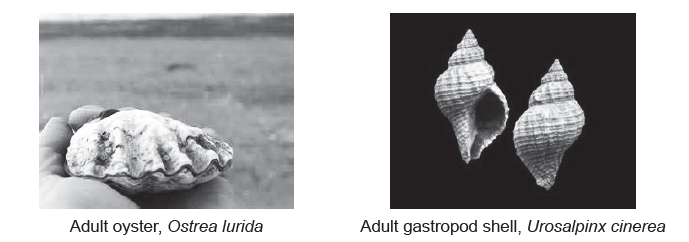
It is known that oysters and gastropods have hard parts composed of calcium carbonate and that ocean acidification is increasing. Studies were carried out using juvenile oysters and gastropods to investigate the effects of acidification on the decrease in the population of oysters.
The first step was to raise oysters in two different mesocosms. One had seawater at a normal concentration of CO2 and the other had sea water with a high concentration of CO2. Gastropods were raised in two further mesocosms with normal and high CO2 concentrations respectively.
A juvenile gastropod will attack a juvenile oyster by using its tongue-like structure (radula) to drill a hole through the oyster shell. Once the hole has been drilled, the gastropod sucks out the soft flesh. Researchers investigated the shell thickness at the site of the drill hole in relation to the size of the oyster. The results are seen in this graph.
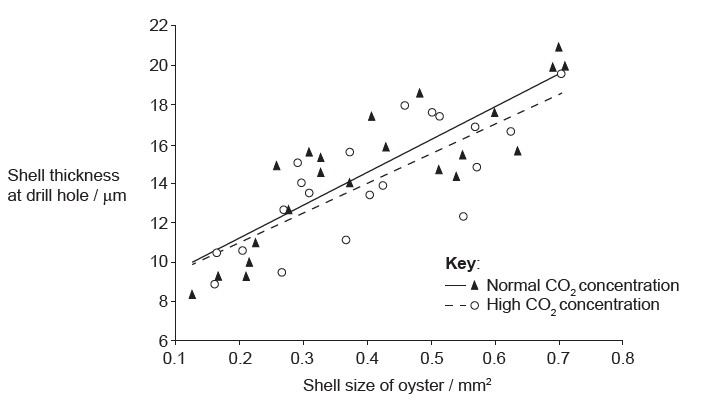
Equal numbers of oysters raised in seawater with a normal CO2 concentration and in seawater with a high CO2 concentration were then presented together to the gastropod predators in seawater with a normal CO2 concentration. The same numbers of oysters from the two groups were also presented together to the gastropods in seawater with a high CO2 concentration. The bar charts show how many of the oysters were drilled by the gastropods and the mean size of drilled oysters.
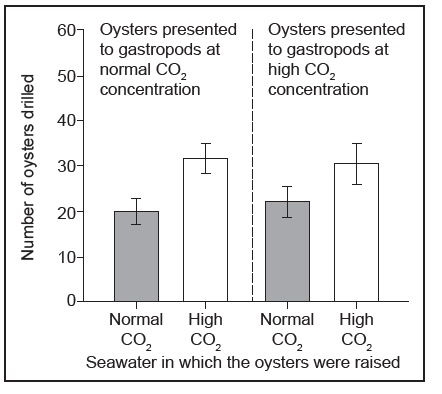
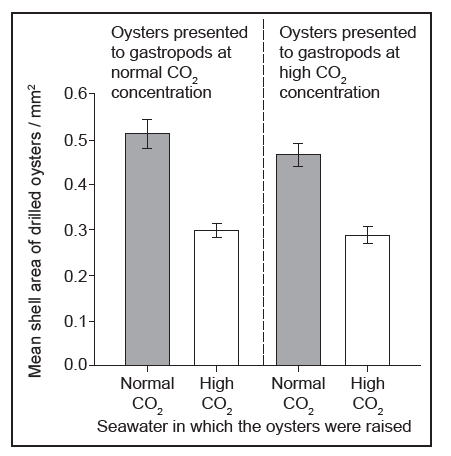
Outline how acidified sea water could affect the shells of the oyster.
Outline the trends shown in the data in the graph.
Estimate how much smaller drilled oysters raised in seawater at a high CO2 concentration were than drilled oysters raised in seawater at a normal CO2 concentration.
Deduce from the data in the bar charts which factors were and were not correlated significantly with the number of oysters drilled by the gastropods.
Suggest reasons for the differences in the numbers of oysters drilled, as shown in the bar charts.
The radula in a gastropod is hard but not made of calcium carbonate. Outline how this statement is supported by the drilling success of the gastropods in seawater with normal or high CO2 concentrations.
Using all the data, evaluate how CO2 concentrations affect the development of oysters and their predation by gastropods.
▶️Answer/Explanation
Markscheme
Shells might dissolve/deteriorate / become smaller/thinner/weaker / OWTTE
OR
shell formation reduced / more difficult
a. positive correlation between shell thickness and shell size
OR
as shell thickness increases, shell size «also» increases
b. (positive correlation) occurs at two different CO2 concentrations / both high and normal concentrations
c. trend for thickness is «slightly» lower with high CO2
«approximately» 0.2 mm2
OR
«approximately» 40 % «smaller»
unit required
a. significant factor: concentration of CO2 in which oysters were raised
b. insignificant factor: concentration of CO2 at which oysters were presented to gastropods
a. (because) shells are thinner/smaller when the oyster is raised in high CO2/lower pH
OR
«because» lower pH/higher acidity prevents/reduces deposition of calcium carbonate
b. gastropods target smaller/thinner-shelled oysters more
c. gastropods can eat/drill thin-shelled/smaller oysters at a faster rate (and move onto another)
d. eating smaller oysters «from high CO2 environments» means given population of gastropods require more oysters for same food intake
a. data shows that similar numbers are drilled regardless of conditions
b. since radulas are not affected by acidification
OR
radulas not made of calcium carbonate so (remain) strong/successful at drilling
a. the data/trend lines indicate that a higher CO2 concentration diminishes the shell thickness, making gastropod predation more successful
OR
the bar graphs suggest that oysters raised in a higher CO2 concentration are smaller, making gastropod predation more successful
b. CO2 concentrations «during feeding» do not change the occurrence of drilling/predation «by gastropods»
c. «limitation» no information about how exaggerated the CO2 concentrations were
OR
«limitation» no information about numbers of gastropods used «in each setting»
